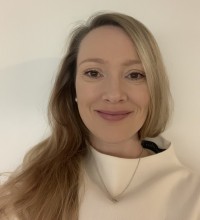Post-Doc Grant enables sleep apnea researcher to join an international research team

When specialist dentist and researcher Satu Strausz heads to Boston with her family in August, it’s more than just a work trip. It’s a step towards a deeper understanding of the genetic and biological factors behind sleep apnea—and an example of how a single grant can have a multilayered impact on a researcher’s career, science, and society at large.
Sleep apnea is a common sleep disorder affecting 10–30% of the working-age population and represents a significant public health challenge. It is a risk factor for cardiovascular diseases, such as hypertension, heart failure, and stroke. Yet sleep apnea often goes undiagnosed, despite its substantial impact on morbidity and mortality.
Doctor of Dentistry Satu Strausz is part of a research group at the Institute for Molecular Medicine Finland (FIMM) at the University of Helsinki, led by Dr. Hanna Ollila, focusing on sleep apnea.
"Our aim is to develop new methods and tools for the early identification of at-risk patients and to tailor treatments individually. This not only supports the health of patients but also eases the burden on healthcare systems," Strausz summarizes.
A €50,000 Post-Doc grant awarded by the Instrumentarium Science Foundation in early 2025 for Strausz’s research project "Finding genetic and epidemiological risk factors of sleep apnea for early prevention and disease endotyping" enables her to spend a year at the Broad Institute in Boston. This interdisciplinary research center brings together Harvard Medical School and the Massachusetts Institute of Technology (MIT) around shared topics.
Clinical observations and statistical data hand in hand
In her research, Satu Strausz focuses on uncovering the genetic and biological mechanisms of sleep apnea using extensive biobank datasets from the United States, the United Kingdom, and Finland. She pays particular attention to patients with structural anomalies in the facial area, which can increase the risk of the disease.
"I’ve been doing research since 2017, and my earlier training as a statistician has given me a strong foundation in combining clinical and computational expertise, something that is crucial for this study."
In her dental work in orthodontics at Helsinki University Hospital (HUS), Strausz has learned to observe patients' facial structures closely. She emphasizes that sleep apnea should not be seen merely as a problem for overweight men; it also affects slim individuals, women, and children, although diagnosis in these groups is often delayed. Awareness needs to be raised.
"I often see facial structural anomalies and breathing issues in my patients, which originally sparked my interest in sleep apnea. Facial structure itself isn’t a disease, it's a variation. But in some cases, it can be a risk factor for sleep apnea, and that fascinates me deeply."
Strausz notes that facial development can already be guided during childhood to reduce the risk of sleep apnea later in life:
"Orthodontic intervention during a child's growth period is both easier on the patient and more cost-effective for the healthcare system compared to lengthy and demanding surgical treatments required in adulthood."
Boston offers new perspectives
Strausz discovered during her PhD work that sleep apnea is a risk factor for severe COVID-19, leading to prioritization for vaccinations.
"More recently, we have identified a genetic susceptibility linked to the serotonin receptor, which might explain the development of sleep apnea in individuals who are not typically overweight. In the future, it would be fascinating to study whether understanding this pathway more precisely could open up new treatment options, especially for those who do not benefit from current therapies like CPAP (continuous positive airway pressure) devices."
Strausz sees the Post-Doc grant as a crucial enabler for strengthening international research networks, deepening global understanding of sleep apnea, and potentially paving the way for new treatments.
"Top sleep researchers are based in Boston. I look forward to meeting them and learning from them. At the same time, I am excited to share the findings from our FIMM research group—such as how Finnish datasets can be leveraged to raise broad awareness. I’m proud to present the excellent registry and genetic data resources we have in Finland. I believe that new ideas can be especially well applied to Finnish material because we can comprehensively track an individual's health over time—thanks to our personal identity code system. This often amazes international researchers," Strausz says, smiling.
She emphasizes how the grant not only allows her to participate in international research but also gives her the opportunity to influence international treatment guidelines, which are often formulated in the United States.
"Although a year abroad is short, its impact can be long-lasting. Research is a continuum—the work we start now could lead to concrete clinical tools within a few years. I don’t yet know what we will discover, but that’s the beauty of research," she says.
Strausz will be accompanied to Boston by her spouse and their 5- and 7-year-old children, so the grant also plays a vital role in organizing daily life for the entire family.
Text: Tia Härkönen
Photo: Helsinki University
